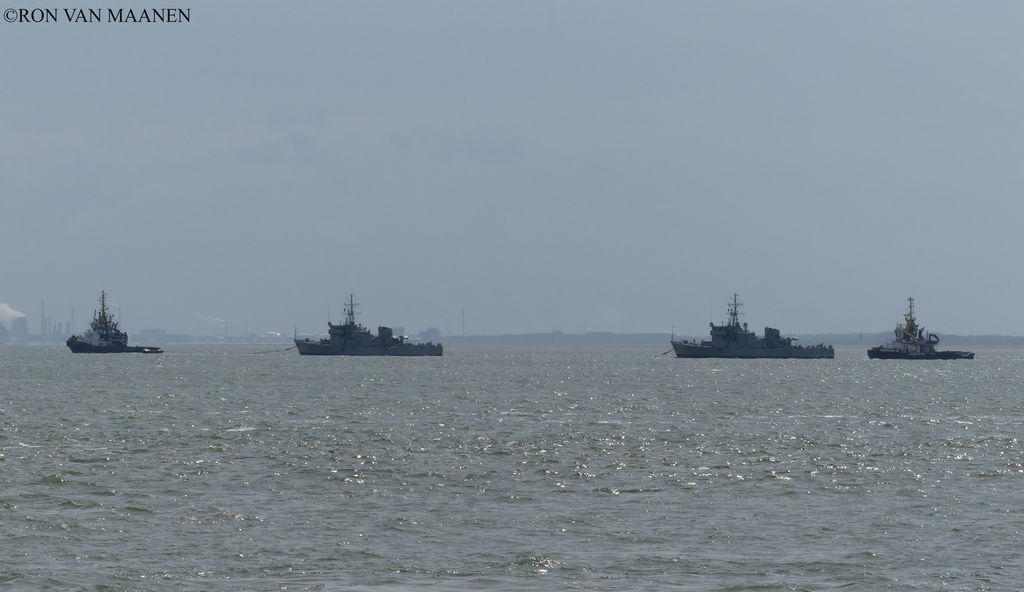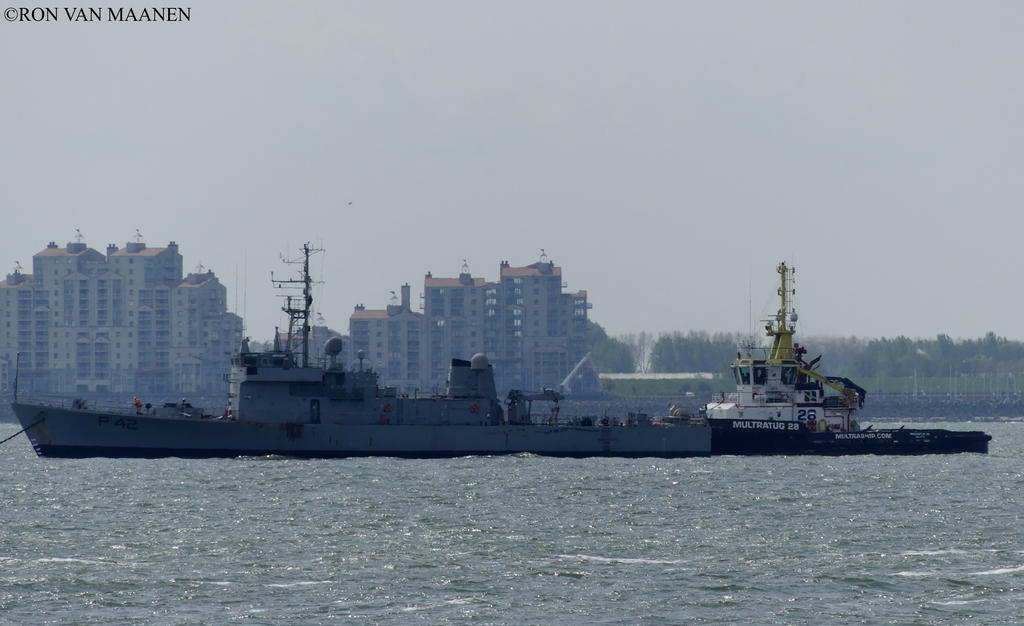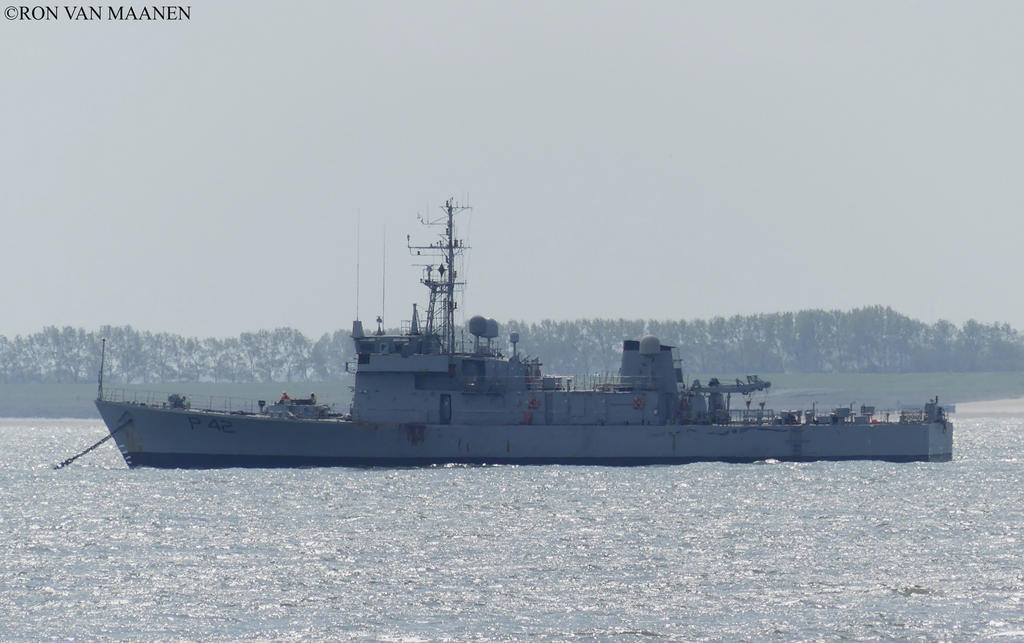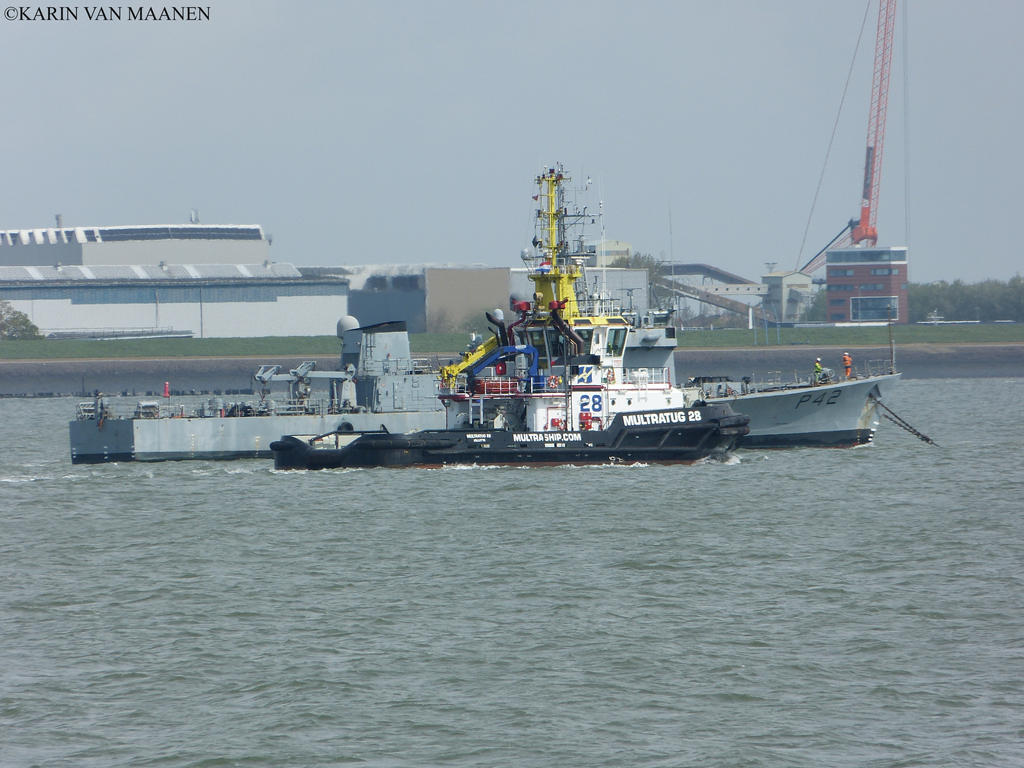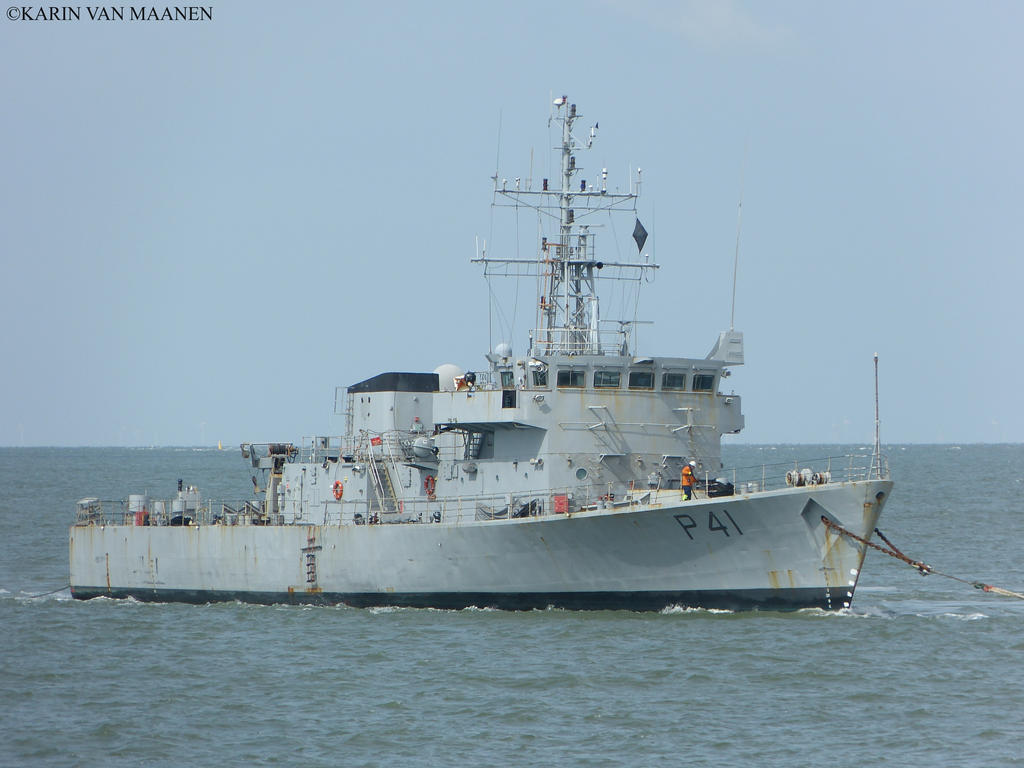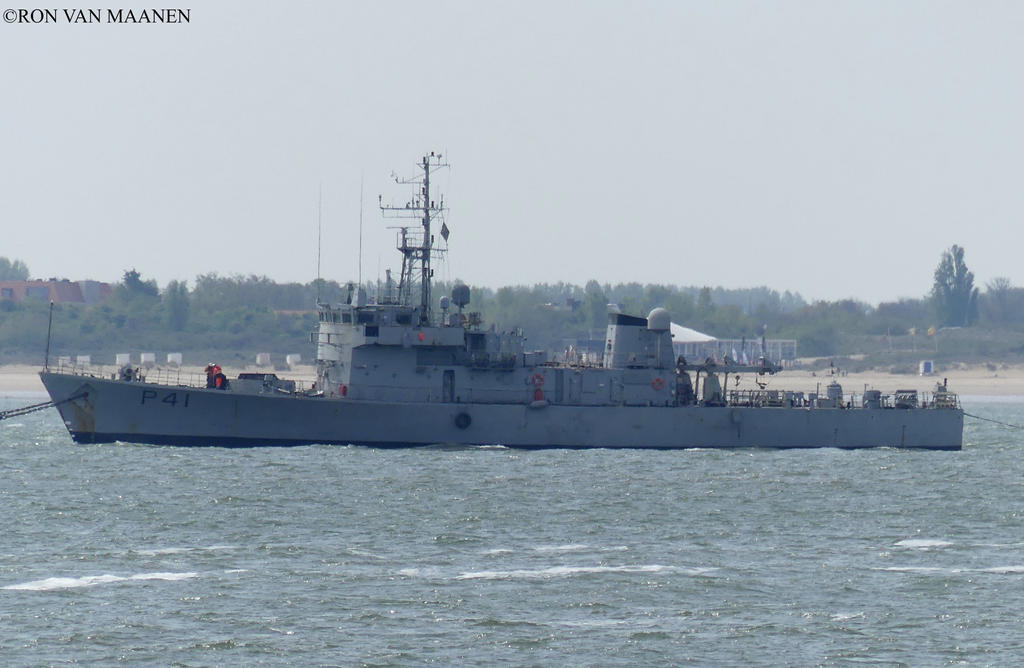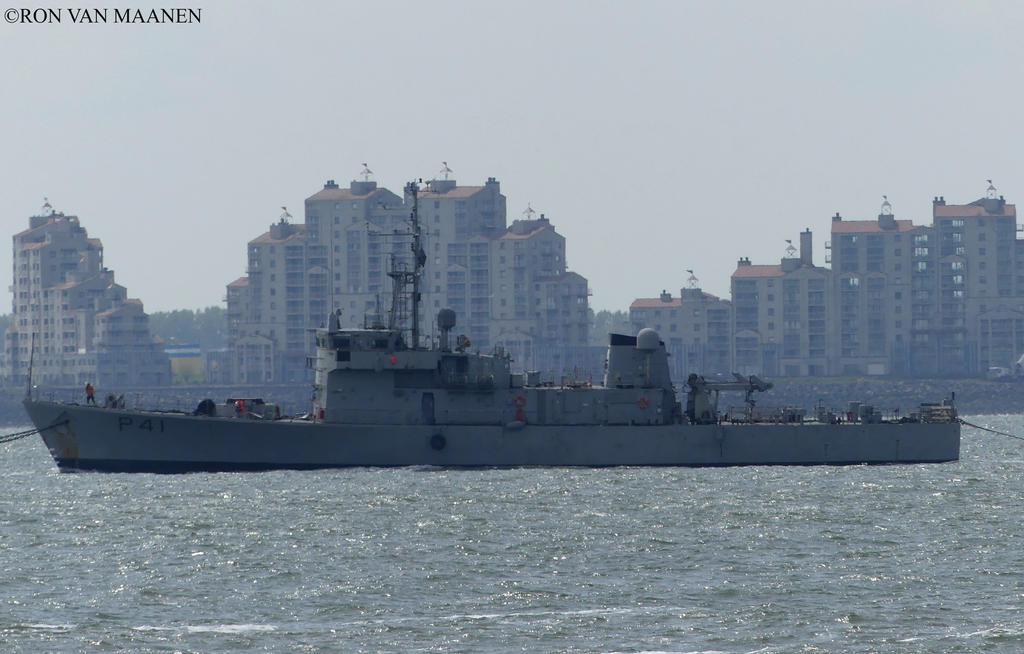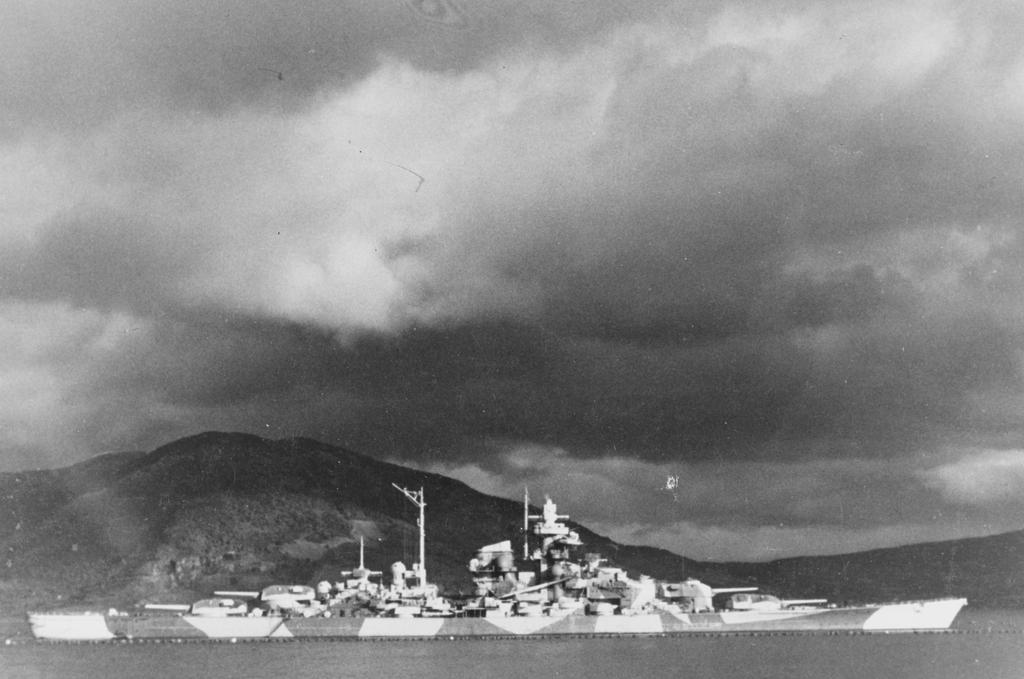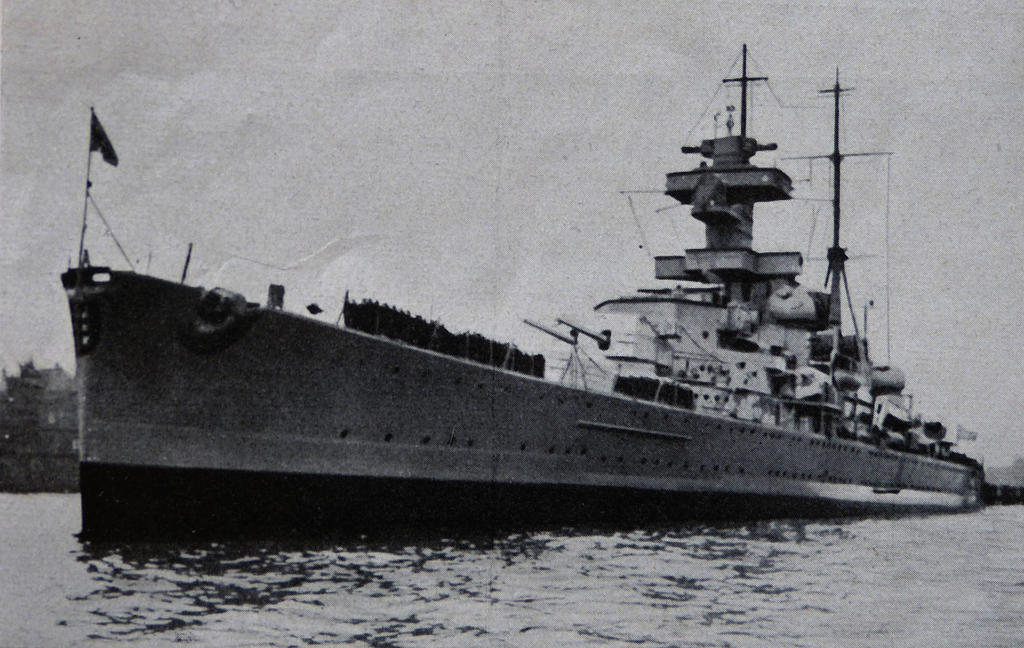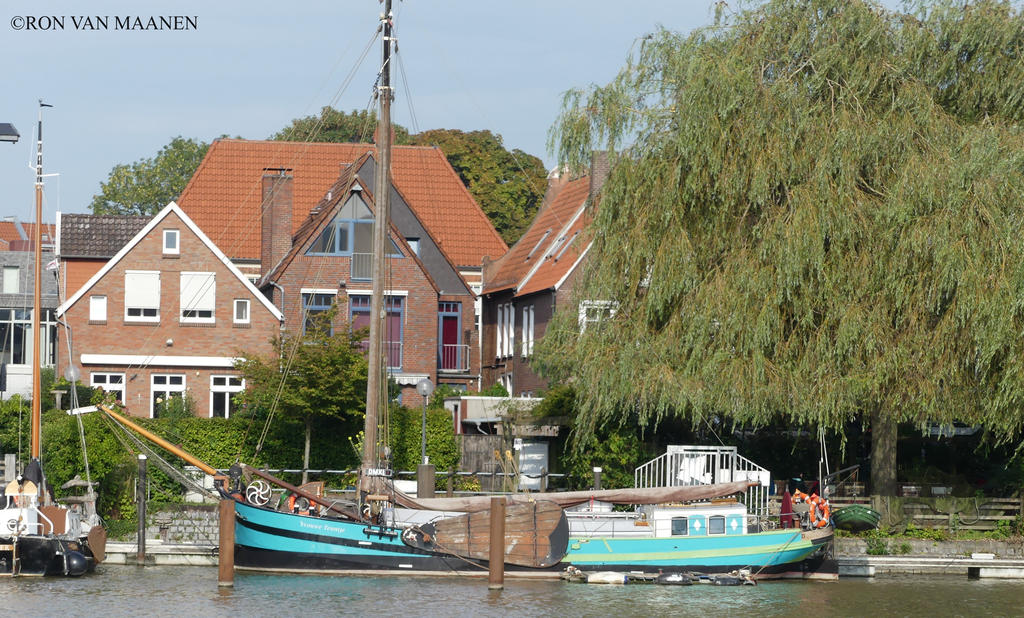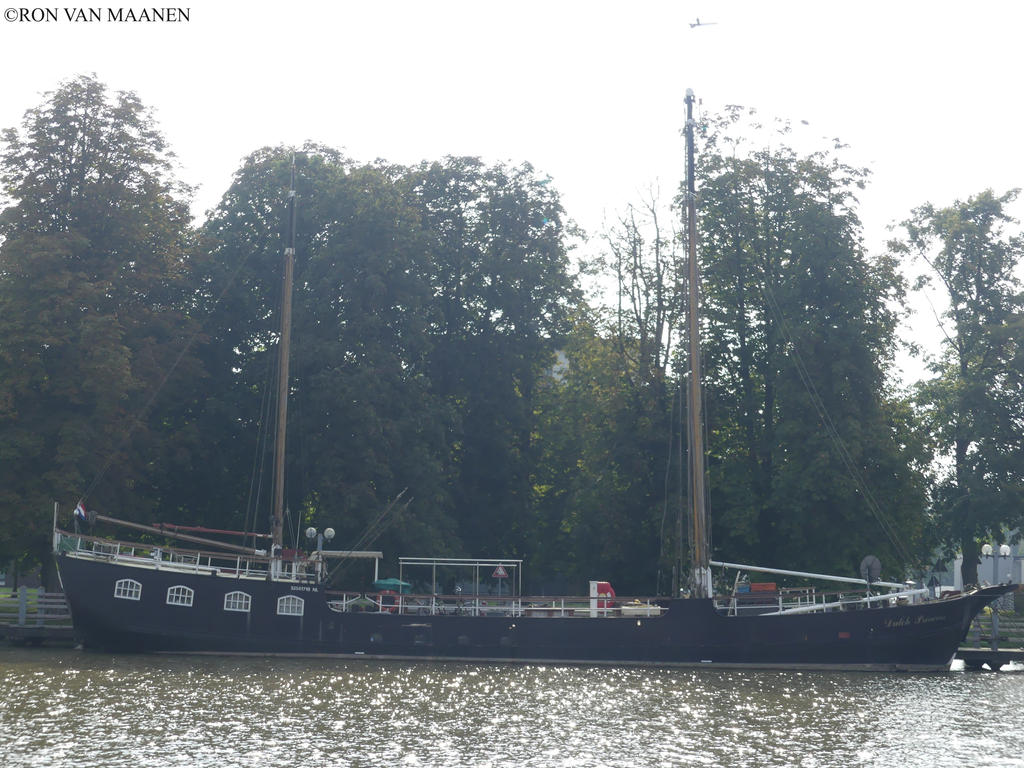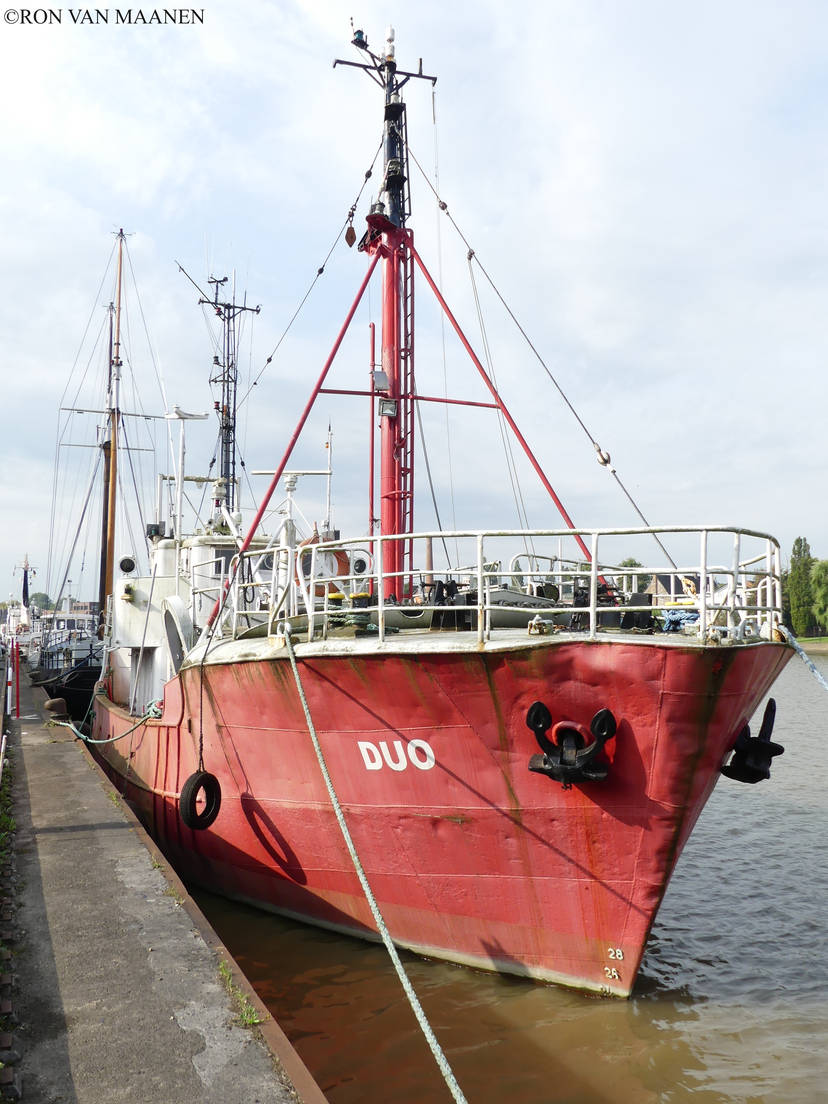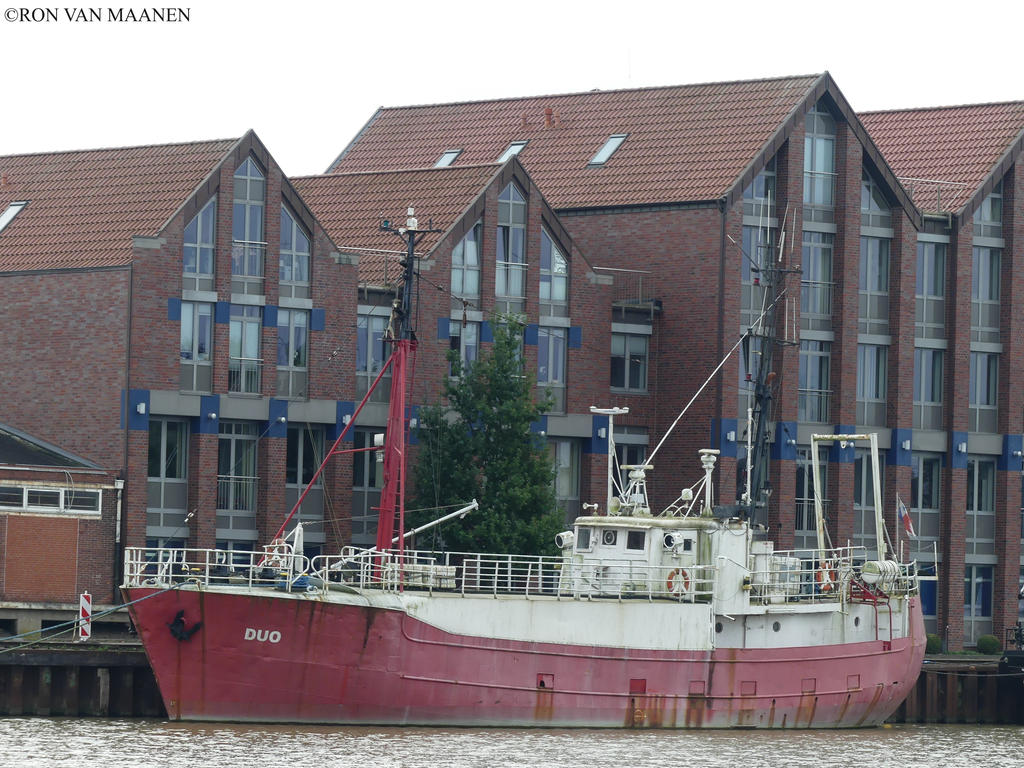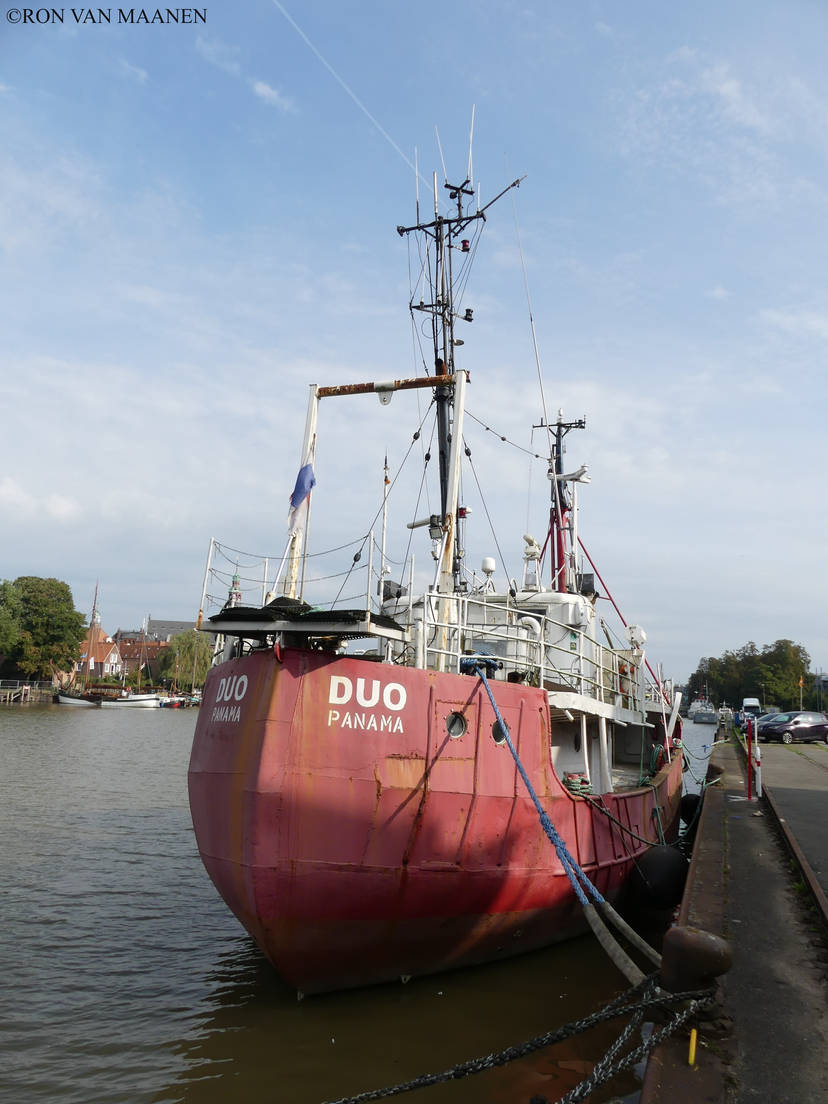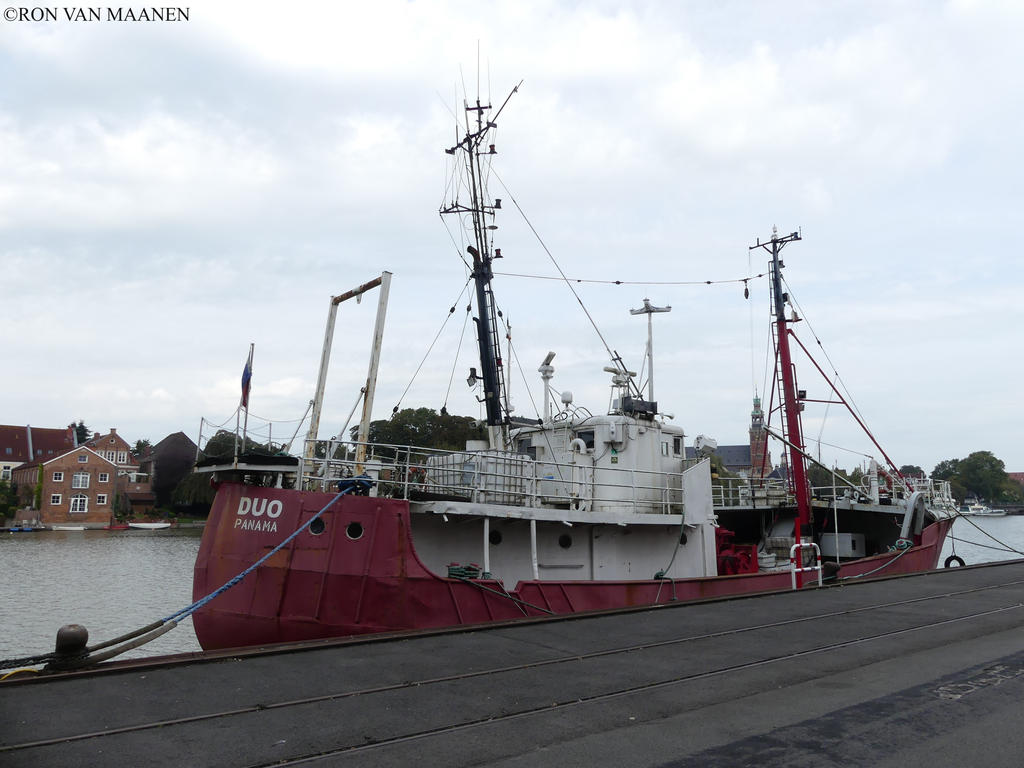France-flagged, homeport Cherbourg, France and MMSI 226121949. Of the French Flamant class OPV54 patrol vessels with as tasks fishery protection SAR and French economic zone protection. Sister ships Coromorant and Pluvier. Ordered in August 1993, laid down in March 1994, launched on 24 April 1995 and commissioned on 18 December 1997. With a displacement of 300 tonnes/295 long tons (standard)-477 tonnes/469 long tons (full load) and as dimensions 54 (over all) x 10 x 2,2 metres or 177’2” x 32’10” x 7’3”. Speed 23 knots. A crew numbering 21 men and an armament consisting of 2-12,7mm machine guns.
Translate
Saturday 27 April 2024
French patrol vessel Flamant (P676) 1993-
Canadian aircraft discovered disguised Japanese submarine according to the U.S. Joint Intelligence Committee. Daily summary dated 14 April 1942
An item reported that a Canadian patrolling aircraft sighted on the position 54.03 North latitude and 132 West Longitude a small fishing boat fitted out with a pole mast. When the aircraft approached disappeared the boat without leaving traces. The pilot believed that he had seen a submarine. The J.I.C. commented that earlier reports confirmed that Japanese disguised their submarines as fishing boats.
Source
Map Room Papers (Roosevelt Administration), 1942 - 1945. U.S. Joint Intelligence Committee. Daily summary No. 125 dated 14 April 1942
Japanese were constructing submarine base on the Warangoi River according to the U.S. Joint Intelligence Committee. Daily summary dated 14 April 1942
An item reported that the Japanese were constructing submarine base on the Warangoi River, New Britain, Bismarck Archipelago [Australian mandated territory].
Source
Map Room Papers (Roosevelt Administration), 1942 - 1945. U.S. Joint Intelligence Committee. Daily summary No. 125 dated 14 April 1942
Shipbuilding, docking and repair facilities at Kawasaki, Japan in February 1937
In his rapport dealing with the Japanese shipbuilding capacity dated 15 February 1937 No.22 file 409-600 the naval attache dealt with naval and merchant shipyards able to built ships larger as 1,000 tons.
Building ways (length in feet on land): No. 1-340, No. 2-383, No. 3-1,000, No. 4-568, No. 5-414, No. 6-283, No. 7-750 and No. 8-750 not yet completed.
Drydocks (length in feet, top): No. 1-428.
%Maximum capacity annual of naval vessels in tons-peacetime conditions: 120,000
%=Capacities in tons displacement derived from the time required to built battleships 3 years, cruisers 2.5 year and destroyers and submarines 1-1.5 years.
Source
National Archives USA. Record Group 38: Records of the Office of the Chief of Naval Operations. Series: Secret Naval Attaches Reports. Report of the Naval Attache Tokyo dated 21 January 1937 No. 12 subject Japanese Navy Vessels Built, Building or Authorized. Information of 1 January. M975-002.
German tug (ex-Orion 1924-1957, Assistent 1957-) Bertus Freede
Built by Scheepswerf Jansen&Schmilinski, Hamburg, Germany in 1924, sold towards Netherlands in 1993 and bought by Schipper-Klottje, Leer in 1998. Dimensions 16.28 x 5.08 x 1.90 metres.
Russian merchant ship ss Don active in the Pacific on 1 July 1944
A report from Op-16-FT, Washington, USA dated 1 July 1944 serial FT-49-44 described all Soviet merchant ships active in the Pacific. On 15 June 1944 were 207 Russian merchant ships with a total gross tonnage of 891,591 tons active in transpacific and coastal waters.This number included for instance 36 Liberty ships. 70% or 627,649 gross tons participated in regular transpacific traffic destinated for Siberian harbors and 95 vessels or 264.942 gross tons in the coastal waters. The 207 vessels excluded 7 icebreakers.
Gross tonnage 1,598 tons. Type freighter. Built in 1922. Speed 8 knots. Fuel coal. International call sign UPLG. Service coastal.
Source
Map Room Papers (Roosevelt Administration), 1942 - 1945. MR450(7) Sec 2 Location of Russian Ships, 1942-1945
Russian merchant ship ss Dneprostroi active in the Pacific on 1 July 1944
A report from Op-16-FT, Washington, USA dated 1 July 1944 serial FT-49-44 described all Soviet merchant ships active in the Pacific. On 15 June 1944 were 207 Russian merchant ships with a total gross tonnage of 891,591 tons active in transpacific and coastal waters.This number included for instance 36 Liberty ships. 70% or 627,649 gross tons participated in regular transpacific traffic destinated for Siberian harbors and 95 vessels or 264.942 gross tons in the coastal waters. The 207 vessels excluded 7 icebreakers.
Gross tonnage 4,5876 tons. Type freighter. Built in 1919. Speed 9 knots. Fuel coal. International call sign UOBH. Service transpacific.
Source
Map Room Papers (Roosevelt Administration), 1942 - 1945. MR450(7) Sec 2 Location of Russian Ships, 1942-1945
German former crab cutter Falke DOR 78 1960-
Leer, Germany 17 September 2023
Call sign DERU. Built by Cuxhavener Bootswerft, Wilhelm Mews, Cuxhaven, Germany in 1960.
Catch results of the German Greenland whaler Juffr. Johanna according to the Dutch newspaper Opregte Leydse courant dated 23 August 1706
An item dated Amsterdam, Netherlands 21 August referred to the arrival at Copenhagen, Denmark of the Danish Greenland whaler Juffr. Elisabeth bringing with her a list of the catch results of the German Greenland whaler Juffr. Johanna of Bremen 1 whale.
Catch results of the German Greenland commandeur Henrik Roelofze according to the Dutch newspaper Opregte Leydse courant dated 23 August 1706
An item dated Amsterdam, Netherlands 21 August referred to the arrival at Copenhagen, Denmark of the Danish Greenland whaler Juffr. Elisabeth bringing with her a list of the catch results of the German Greenland commandeur Henrik Roelofze of Bremen 1,5 whale.
German tug (ex-Bardenfleth 1970-1993) EMS Pull 1993-
Madeira International Register/Portugal-flagged, IMO 7017909, MMSI 255805540 and call sign CQJD. Former homeport St. John’s, Antigua and Barbuda. Owner/manager EMS Offshore Service Gmbh&Co., Leer, Germany. Built by Elsflether Werft, Elsfleth, Germany in 1970.
French privateer la Friponne 1696
Homeport Dunkirk. Master Jean Blanckeman. Measurement 100 tons. Armament 10 guns. Crew 72 men.
Source
H. Malo Les Corsaires dunkerquois et Jean Bart, vol. 2.
French privateer la Levrette between 1692-1693
Homeport Dunkirk. Master Jean Blanckeman.
Source
H. Malo Les Corsaires dunkerquois et Jean Bart, vol. 2.
German inland tug (ex-Donau) Trude 1932/1939-
Built by G. den Heeten, Leiderdorp, Netherlands in 1932 or 1939. Dimensions 9.15 (over all) x 2.83 (over all) x ca. 0.90 metres.
Theoretical performance of a NH3/L-fuelled sea control ship (SCS) in 1975
Smaller air-capable sea control ship designed to operate helicopters and V/STOL aircraft. Fuel weight 1,306 LT. Dimensions 612.5 x 79.0 x 22.6 x 52.9 (freeboard) feet. Range 5,200 (at 30 knots)-2,400 (at 50 knots) nautical miles.
Performance of a representative DFM-fuelled sea control ship (SCS) in 1975. Smaller air-capable sea control ship designed to operate helicopters and V/STOL aircraft, displacement light 14,000 tons. Dimensions 612 (waterline) x 78.9 (waterline) x 22.6 (ship draft) x 52.8 (ship freeboard) feet. Propulsion 1 screw. Horsepower 40,000 hp. Maximum speed 27 knots. DFM fuel weight 1,320 LT. Cruising speed 20 knots. Range at cruising speed 12,000 nautical miles based on 10 percent fuel reserve rounded to nearest 50 nautical miles.
Sea control ship (SCS) general applicable for the next specific warfare areas:
ASMD=self protection against anti-ship missiles
ASW (P)=force protection against subsurface threats
AAW=fore attribution of airborne threats
ASUW=warfare against surface ship threats
ARW=strike warfare using carrier-based tactical air
EW=electronic warfare
CAC=command, control and communication
CDS=combat direction systems
SURV=surveillance
MIW=mine warfare
SPW=special warfare
Principal mission characteristics
Mission: sea control task force defense
Duration in day: 24.6
Range in nautical miles: 12,1000
Mission description: escort of task force to/from operation area. Five days in operation area. Continuous VSTOL and ASW helo stations maintained in transit and op area
Ship operational parameters
Days in transit: 19.6
Transit day profile hours: 8
Transit day profile in knots: 24
Transit day profile in nautical miles: 192
Days in op area: 5?
Op area day profile in hours: 4
Op area day profile in knots: 24
Op area day profile in nautical miles: 9
Total time at speed in hours: 312
Total time at speed in knots: 24
Ship operational parameters
Days in transit:
Transit day profile hours: 16
Transit day profile in knots: 20
Transit day profile in nautical miles: 320
Days in op area: 5
Op area day profile in hours: 20
Op area day profile in knots: 16
Op area day profile in nautical miles:320
Total time at speed in hours: 100
Total time at speed in knots: 16
Number of embarked aircraft: 10 VSTOL-10 Helo ASW
Sorties per aircraft-day: 2.0 both types
Hours per sortie: VSTOL 1.44-Helo 4.0
Number of aircraft flying per day transit: VSTOL 9-Helo 6
Number of aircraft flying per day op area: VSTOL 9-Helo 3
Source
Hydrogen. Hearings before the subcommittee of energy research, development and demonstration of the committee on science and technology U.S. House of Representatives. Ninety-fourth congress, first session June 10 and 12, 1975, p. 1027 and further.
Friday 26 April 2024
Irish patrol vessel (ex-HMS Swallow P242 1984-1988) Lé Ciara P42 1988-2022 (2024)
Ireland-flagged, IMO 8119326, MMSI 250104000 and call sign EIYT. eacock-class preceded by Castle-class succeeded by British River-class and Irish Róisín-class, to serve in the British Royal Navy at Hong Kong, launched by Hall Russell&Company, Aberdeen, Scotland with yard number 991 on 30/31 March 1984, completed on 17 October 1984, sold to Ireland in 1988, commissioned on 16 January 1989, decommissioned on 8 July 2022 and sent to the scrapyard in April 2024.
Shipbuilding, docking and repair facilities at Osaka Iron Works, Sakurajima, Japan in February 1937
In his rapport dealing with the Japanese shipbuilding capacity dated 15 February 1937 No.22 file 409-600 the naval attache dealt with naval and merchant shipyards able to built ships larger as 1,000 tons.
Building ways (length in feet on land: No. 1-305, No. 2-600, No. 3-558, No. 4-505 and No. 5-507
Drydocks (length in feet, top): No. 1-684, wood.
%Maximum capacity annual of naval vessels in tons-peacetime conditions: 130,000.
%=Capacities in tons displacement derived from the time required to built battleships 3 years, cruisers 2.5 year and destroyers and submarines 1-1.5 years.
Source
National Archives USA. Record Group 38: Records of the Office of the Chief of Naval Operations. Series: Secret Naval Attaches Reports. Report of the Naval Attache Tokyo dated 21 January 1937 No. 12 subject Japanese Navy Vessels Built, Building or Authorized. Information of 1 January. M975-002.
German batlehsips Gneisenau and Schlesien seemed to be in the eastern Baltic area according to the U.S. Joint Intelligence Committee. Daily summary dated 16 April 1942
An item reported that the German battleship Gneisenau (1) which left Kiel, Germany between 29 March-12 April with an unknown destination was gone to the eastern Baltic area. The aged battleship Schlesien (2) and the light cruiser Leipzig (3) seemed to be there also.
Notes
1. Of Scharnhorst-class preceded by planned L20e α-class and realized Bayern-class preceded by Bismarck-class, laid down by Deutsche Werke, Kiel, Germany on 6 May 1935, launched on 8 December 1936, commissioned on 21 May 1938, decommissioned on 1 July 1942, scuttled as block ship on 23 March 1945 and broken up in 1951.
2. Part of Deutschland-pre dreadnoughts preceded by Braunschweig-class succeeded by Nassau-class, ordered under contract name “R” on 11 June 1904, laid down by Schichau, Danzig, Germany on 19 November 1904, launched on 28 May 1906, commissioned on 5 May 1908, decommissioned on 1 December 1918, modernized mid-1920s, recommisioned on 1 March 1927, mined off Swinemünde on 3 May 1945 and broken up between 1949-1956.
3. Part of Leipzig-class light cruisers preceded by Königsberg-class succeeed by planned M-class cruiser, laid down at Rechsmarinewerft, Wilhelmshaven, Germany on 28 April 1928, launched on 18 October 1929, commissioned on 8 October 1931, barracks for minesweepers in 1945 and scuttled in 1946.
Source
Map Room Papers (Roosevelt Administration), 1942 - 1945. U.S. Joint Intelligence Committee. Daily summary No. 127 dated 16 April 1942.
Irish patrol vessel (ex-HMS Swift P243 1984-1988) Lé Orla P 41 1988-2022 (2024)
Ireland-flagged, MMSI 250103000 and call sign EIYQ. Peacock-class preceded by Castle-class succeeded by British River-class and Irish Róisín-class, to serve in the British Royal Navy at Hong Kong, laid down by Hall Russell&Company, Aberdeen, Scotland in 1984, launched on 11 September 1984, purchased by Ireland, commissioned on 19 January 1989, decommissioned on 8 July 2022 and sent to the scrapyard at Ghent, Belgium in April 2024.
German battleship Tirpitz and other major units still berthed in Norwegian Trondheim Fjord according to the U.S. Joint Intelligence Committee. Daily summary dated 14 April 1942
An item reported that on 13 April the German battleship Tirpitz (1), the pocket battleship Admiral Scheer (2) and the heavy cruisers Prinz Eugen (3) and Hipper (4) still were lying on the usual berths in the Trondheim Fjord, Norway. The location of the battleship Gneisenau (5) was since 29 March when she was at Kiel, Germany unknown.
Notes
1. Laid down by Kriegsmarinewerft Wilhelmshaven, Germany on 2 November 1936, launched on 1 April 1939, commissioned on 25 February 1941 and sunk by the Royal Air Force on 12 November 1944 at Tromsø, Norway, with her wreck broken up between 1948-1957. Of the Bismarck-class as answer on the French Richelieu-class battleships preceded by Scharnhorst-class succeeded by planned H-class.
2. Of the Deutschland-class panzerschiffe later classified as heavy cruisers preceded by the Admiral Hipper-class. Main armament 2x3-28cm/11” guns on fore and aft ship one turret. Laid down by Kriegsmarinewerft Wilhelmshaven, Germany on 25 June 1931, launched on 1 April 1933, commissioned on 12 November 1934, sunk during an air attack at Kiel, Germany on 9 April 1945, partly broken up and the remains used of filling up the inner part of the dockyard.
3. Of the Admiral Hipper-class heavy cruisers, preceded by Deutschland-class. Laid down by Germaniawerft, Kiel on 23 April 1936, launched on 22 August 1938, commissioned on 1 August 1940, decommissioned on 7 May 1945, surrendered on 8 May 1945, handed over to the USA and sunk on 22 December 1946 during nuclear tests.
4. Of Admiral Hipper-class heavy cruisers, preceded by Deutschland-class, succeeded by the planned P-class, laid down by Blohm&Voss, Hamburg, Germany on 6 July 1935, launched on 6 February 1937, commissioned on 29 April 1939, scuttled on 3 May 1945 and between 1948-1952 salvaged and broken up.
5. Of Scharnhorst-class preceded by planned L20e α-class and realized Bayern-class preceded by Bismarck-class, laid down by Deutsche Werke, Kiel, Germany on 6 May 1935, launched on 8 December 1936, commissioned on 21 May 1938, decommissioned on 1 July 1942, scuttled as block ship on 23 March 1945 and broken up in 1951.
Source
Map Room Papers (Roosevelt Administration), 1942 - 1945. U.S. Joint Intelligence Committee. Daily summary No. 125 dated 14 April 1942
Enemy submarine active off Brazilian coast according to the U.S. Joint Intelligence Committee. Daily summary dated 14 April 1942
An item reported that one or even more enemy submarines were active off the Brazilian north coast especially in the Parnahyba area and in the past week sunk or damaged at least four ships. In the Caribbean area were no attacks reported and north of that area in the western Atlantic theatre was the number of enemy submarines unchanged.
Source
Map Room Papers (Roosevelt Administration), 1942 - 1945. U.S. Joint Intelligence Committee. Daily summary No. 125 dated 14 April 1942
German sailing cargo ship Vrouwe Teuntje 1897-
Leer, Germany 17 September 2023
Originally cutter rigged, later fitted out with an engine. Dutch inland clipper built at Ruitenberg Werft, Waspik, Boven, Netherlands in 1897. Former names Vadder Gerrit II, Vrouwe Anna, George, Yvone, Breydel, Josephine and Albert.
Two-mast flat bottom clipper Dutch Princess (1902)
Germany-flagged, homeport Leer, in 2024 for sale in the Netherlands. Built in 1902 and in 1997 using her casco completely rebuilt. Registration 32501718 NL.
Russian merchant ship ss Dvina active in the Pacific on 1 July 1944
A report from Op-16-FT, Washington, USA dated 1 July 1944 serial FT-49-44 described all Soviet merchant ships active in the Pacific. On 15 June 1944 were 207 Russian merchant ships with a total gross tonnage of 891,591 tons active in transpacific and coastal waters.This number included for instance 36 Liberty ships. 70% or 627,649 gross tons participated in regular transpacific traffic destinated for Siberian harbors and 95 vessels or 264.942 gross tons in the coastal waters. The 207 vessels excluded 7 icebreakers.
Gross tonnage 1,773 tons. Type freighter. Built in 1922. Speed 7 knots. Fuel coal. International call sign UOAM. Service coastal.
Source
Map Room Papers (Roosevelt Administration), 1942 - 1945. MR450(7) Sec 2 Location of Russian Ships, 1942-1945
Russian merchant ship mv Donbass active in the Pacific on 1 July 1944
A report from Op-16-FT, Washington, USA dated 1 July 1944 serial FT-49-44 described all Soviet merchant ships active in the Pacific. On 15 June 1944 were 207 Russian merchant ships with a total gross tonnage of 891,591 tons active in transpacific and coastal waters.This number included for instance 36 Liberty ships. 70% or 627,649 gross tons participated in regular transpacific traffic destinated for Siberian harbors and 95 vessels or 264.942 gross tons in the coastal waters. The 207 vessels excluded 7 icebreakers.
Gross tonnage 7,302 tons. Type tanker. Built in 1941. Speed 11.5 knots. Fuel oil. International call sign UPTE. Service transpacific. Remarks lend-lease.
Source
Map Room Papers (Roosevelt Administration), 1942 - 1945. MR450(7) Sec 2 Location of Russian Ships, 1942-1945
Panamanian ordnance clearance vessel (ex-Eisha 1958-2012) Duo 2012-
Panama-flagged, homeport Panama, IMO 5099202, MMSI 372873000 and call sign HP4964. Renamed June 2012. Operator Duo Surveys Ltd., Pamama. Built as fishing vessel by Elbewerft Boizenburg, Boizenburg, East Germany in 1958.
American whaler Clement visited Honolulu, Hawaii according to the newspaper The Polynesian dated 16 November 1850
An item reported that at Honolulu, Hawaii on 11 November the American whaler Clement master Lane was cleared for New London
French whaler Salamandre visited Honolulu, Hawaii according to the newspaper The Polynesian dated 16 November 1850
An item reported that at Honolulu, Hawaii on 9 November the French whaler Salamandre master Gueden was cleared for Le Havre, France















